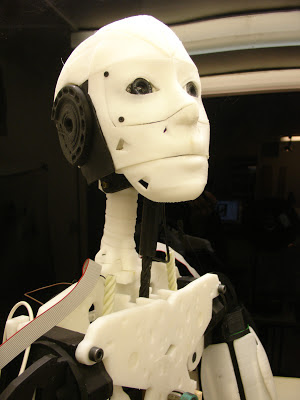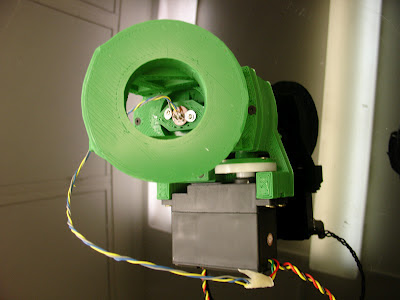I had bought a fancy power supply thinking "This is The One" that will power the whole robot, but I guess I was wrong. You see since the beginning of this project I had been using a very small power supply DC6V3A I had laying around in my workshop. But by adding more and more servos to it, I came to realize it was not enough anymore to power up the 22 servos of InMoov. During the initialization, each servo seems to draw about 2 Amps. I guess I was just lucky with my small supply to already be able to run the arm and not fry it instantly.
So I got "The One" after searching quite a bit on the net, it seemed to have the amps I required and the 6V I needed for the servos I'm using.
This thing was expensive, but it was sold by the same kind of shop that sales servos for hobbiest so I thought it must be compliant. I'm no electrician, I do all those things by guessing...
Okay, I received the Power supply, I was excited because I was going to finally get the whole robot to move. First thing I did was to test with a simple Arduino sketch with only one servo. It worked perfect!
Since I had the right arm connected to the Arduino Uno, I plugged it and ran the simple Arduino sketch again. Perfect!!
At that point I had to think of making a small pcb board to connect all my servos and my two Arduino board all to that single power supply.
Once again I ran a simple test with my two Aduino boards and only 8 servos attached. It went perfect again!
Boy, was I getting excited!
So I went straight forward and plugged every thing together, 22 servos, 2 Aduinos, 1 power supply. I had used only one side of the output of the power supply, instead of both, which can each deliver 20Amps and I think here lays my mistake.
I ran the simple sketch which is only moving all the servos from, let say, 0 to 30 position. Some of the servos were already at 0 position. Then they all had to move to their new positions, here started some strange behaviours. Some of the servos were jittering (shaking), and the movements of the robot became erratic.
I unplugged everything, rechecked all my connections, everything seemed okay.
At that point I thought, I must have plugged or touched something that did that strange acting, and decided to go on.
So excited I was , it was the time to get InMoov controlled through Myrobotlab.
Here starts the initialization, and I get this same kind of strange behaviour, all servos buzzing, erratical moves.
Then all of a sudden one of the arm starts to twist way further then what it is supposed to do!!
WOW! I unplugged everything...
I ran the same test again, but this time everything went off at once, no more power. The power supply is protected against short circuit, thermal heat, and overload drawing.
I checked all the connections one by one again, nothing was wrong.
What was the problem, so I restarted with my first initial test, 1 Arduino, 1 servo, simple sketch, it was not perfect at all anymore. It was acting totally erraticaly...!
And since then of on.
There must be something damaged in the power supply, strangely if I use it with another device, like a little DC motor, it works normal.
So, end of the story, back in search on the net. I read on this page what I hadn't found before about switching power supplies with servos.
Now, I have ordered three batteries with a small charger. They were very cheap when I passed my order, 8 euros per battery. I think that will do for now, I also had found some Lipo batteries but they are rather expensive.
I really would rather a power supply, because I just don't want to have doubts about the power or wait for charging time. I need a DC 6V 44Amps or more, no swithching, with a 250V input.
Would be great if someone has an idea. Any suggestion is welcomed, please post in the comments.
In the meanwhile I have been designing and printing more parts for the head. I also redesigned the top of the front torso, the other was going too high in the middle, and it bothered me because it wasn't taking a human shape structure.
The jaw has it's own servo motor mounted and can be actionned. I still need to test the microphones in the ear circus amplifiers, but this is pure creating guessing. I have no idea if it's going to help InMoov to hear better the voice commands. But hey, why not try something different since I can print and design what ever I want!
 |
| Robot head sideway without ear |
 |
| InMoov has ears and jaw attached |
 |
| Changements have been done on the torso structures of InMoov |






















































